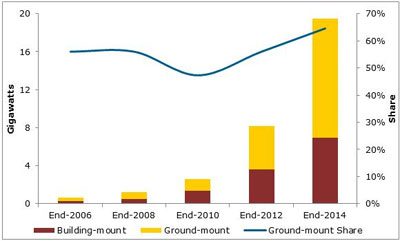One of the hot – and sadly frustrating – topics we’re covering a lot right now is the sudden attack on renewable energy in the US from utilities and petroleum interests.
Add this to the threats they feel about the blossoming of solar in particular: Barclays just downgraded the entire electric utility sector to Underweight in the US high-grade corporate bond market.
Why? Because the industry has long-term challenges from solar energy but they aren’t priced in, reports Michael Aneiro in a Barron’s blog. Since utilities comprise about 7.5% of Barclays’ U.S. Corporate Index by market value, this is pretty significant, he says.
Aneiro points to Barclay’s commentary:
"Electric utilities… are seen by many investors as a sturdy and defensive subset of the investment grade universe. Over the next few years, however, we believe that a confluence of declining cost trends in distributed solar photovoltaic power generation and residential-scale power storage is likely to disrupt the status quo.
Based on our analysis, the cost of solar + storage for residential consumers of electricity is already competitive with the price of utility grid power in Hawaii. Of the other major markets, California could follow in 2017, New York and Arizona in 2018, and many other states soon after.
In the 100+ year history of the electric utility industry, there has never before been a truly cost-competitive substitute available for grid power. We believe that solar + storage could reconfigure the organization and regulation of the electric power business over the coming decade. We see near-term risks to credit from regulators and utilities falling behind the solar + storage adoption curve and long-term risks from a comprehensive re-imagining of the role utilities play in providing electric power."
Barclays says that current valuations do not factor this shift in and utilities that are slow to adapt are becoming risky. Its recommendation: rotate out of utility bonds in areas "where solar + storage is closer to competitiveness" and move into those where the transformation is more distant.
Money Flows to Solar
Meanwhile, solar leasing companies has become a magnet for investors.
Last week, Sunrun raised $150 million in its fifth round of financing for residential solar systems, after Clean Power Finance raised $200 million, Sungevity, $70 million, and SolarCity, $500 million.
The US hit 10 gigawatts (GW) of solar last year and is on course to double that by the end of this year, according to Solarbuzz in its North America PV Markets Quarterly.
Continuing cost declines and a push toward development in advance of the possible elimination of the federal investment tax credit in 2016 are driving growth, they say.

But the challenges we’re seeing to state Renewable Portfolio Standards and net-metering programs could become a real problem, along with uncertainty related to solar trade with China. When the US imposed tariffs on solar panels from China, manufacturers simply moved the assembly to Taiwan – the subject of a federal investigation.
"If state-level policies are dramatically scaled-back, or the supply of PV modules is severely restricted, this could prompt a decline in demand or an increase in pricing," says Solarbuzz.
Solar Prices Trump Coal, Gas
Indeed, Abengoa says concentrating solar with energy storage will compete with natural gas by 2020 in its ability to provide baseload power and on price.
Capital costs are dropping dramatically and solar plants are becoming more efficient, says Abengoa. Its Cerro Dominador solar plant in Chile, for example, will have a capacity factor of about 80% – in the range of most fossil fuel plants.
When it comes to coal, Citigroup is among the many analysts sounding the deathnell. As many as 60 GW of coal plants could close in the next few years in the US where "demand is in structural decline as environmental pressures rise and costs of alternative energy sources decline. The shale gas revolution was the first blow, but rapidly declining wind and solar costs and the spread of unconventional gas production techniques are set to erode coal’s long-time cost advantage over alternative electricity sources."
You can see it in the price of coal, they say, down to $72 a ton this year, "well below break-even estimates of most coal mines."
Citi’s two reports are: A New Balance of Power, A Short Gas Bridge to Renewables, and Global Thermal Coal: When Cyclical Supply Met Structural Demand.
In yet another milestone, during the first quarter of 2014, renewable energy provided more energy than big hydroelectric power in the US – over 50%, according to the International Energy Agency.
Meanwhile, while Republicans get ready to fight the "War on Coal," for supposedly taking jobs from people, the US solar industry employs more people than the coal and gas industries combined.
